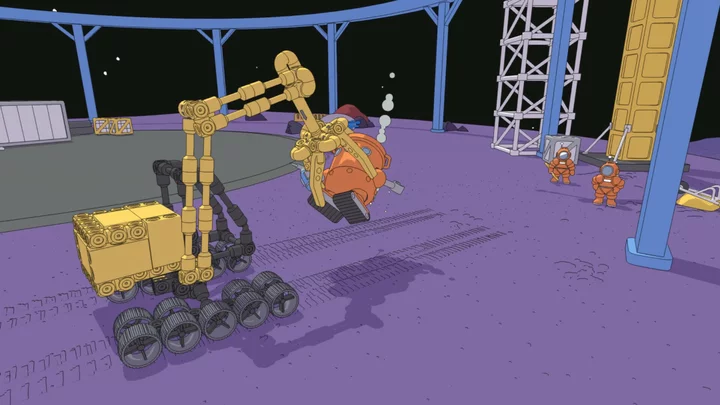Have you ever pondered upon the beauty of the opposable thumb? Jutting from the palm like the prow of a ship, proud and strong, with self-assured dexterity and confidence. If you've taken these remarkable appendages for granted, rest assured: Mars First Logistics will fix that.
Developed by indie Australian studio Shape Shop, Mars First Logistics is a physics simulator that essentially has you building K'Nex to run errands in space. The premise of the game is simple, mirrored by a clean, cartoonish art style that makes liberal use of flat colours and cel-shading. Mars First Logistics places you into the role of an intrepid reconfigurable space rover, tasked with transporting cargo between various structures on a growing Martian base.
SEE ALSO: Raising sim 'Volcano Princess' lets you minmax a digital daughterFortunately, your inorganic body allows you to withstand the cold vacuum of space, as well as the inevitable tumble off a Martian cliff. Unfortunately, said body doesn't provide you the benefit of thumbs.
Your delivery is on its way
Do you know how frustrating it is to be an innocent little dune buggy, staring up at a crate on a high shelf and picturing how easy it would be to reach up and grab it if only you had meat hands? Instead I am reduced to cobbling together an abomination of a crane, then reversing and accelerating for several long minutes in an attempt to knock the accursed thing down so I can run it over.
Unlike vehicular delivery systems on Earth, Mars First Logistics has neither paved roads nor able-bodied workers who are willing to physically place goods onto a vehicle. Instead, you must redesign and contort your truck body to have the function necessary for transporting objects to their destination. It doesn't matter how you get them there, whether by picking them up, carrying them, or more likely dragging them across the dusty Martian dunes. As long as you move them from point A to point B, your job is complete.
Credit: Mashable Credit: MashableThis may seem a straightforward task, and sometimes it is. For preliminary jobs such as moving a comically oversized watering can across largely flat terrain, Mars First Logistics offers a simple vehicle blueprint such as the aptly named Watering Can Lifter, which you can select to instantly build. Simply hook its mechanised claw into the watering can handle, and away you go.
Unfortunately, transporting items such as umbrellas later on is a markedly less simple matter, particularly when said umbrellas insist on popping open to actively work against you like a schadenfreude sail. They also have no loops you can hook into, or large bulk you can easily clamp on, requiring you to get creative with your vehicle design.
SEE ALSO: 10 years on, 'Kerbal Space Program' shoots for more distant stars Credit: Shape ShopMars First Logistics' building system is simple to use. Players start with a blueprint vehicle, then simply add and subtract parts to create a new one, selecting them from their inventory and attaching them to the frame. New parts are either awarded by completing delivery tasks, or purchased with funds earned on these missions.
One frustration is that there's currently no way to detach a whole segment and set it aside to reattach later. So if you make a mistake and don't realise until further along, you'll have to delete all your progress from that point in order to fix it. You also can't automatically duplicate or mirror segments, which means you have to build everything piece by piece.
As such, you'll be better off if you carefully consider your design from the start, rather than throwing parts together and hoping for the best.
If you're the type of person who builds mechas in Legend of Zelda: Tears of the Kingdom, you'll probably have a field day with Mars First Logistics. Engineers will have a lot of fun too. But if, like me, you frequently opt for brute force to solve video game problems, you may have a more difficult time.
SEE ALSO: I still play Pokémon like an aggressive child and I regret nothing Credit: Shape ShopLeave your package in a safe place
Even if you do manage to haul your unruly cargo to the drop off point, delivery can be a whole issue by itself. Rather than letting you dump your goods at the dropoff point, Mars First Logistics obligingly provides a glowing rectangle of light outlining where you need to deposit your package.
This is helpful in that it shows you exactly where you need to go. It is less helpful in that the glowing rectangle is sometimes on top of a very tall building, or on a plinth, or configured in such a way that you need to stand a metal beam on its end in order for your delivery to be accepted. It's like the Firefighter Combat Challenge, only for UPS delivery drivers without hands.
Credit: MashableThe few astronauts milling around are absolutely no help either. These self-centered Stay-Puft marshmallow men will happily ignore your extremely obvious struggle, only caring enough to jetpack out of the way if it seems like you'll run into them. And you will want to run into them, if only due to their refusal to use their perfectly good opposable thumbs in any sort of useful manner.
It does feel a bit lonely. Space is isolating enough without getting ostracised by the mean girls of Mars.
You also don't have any friends who can assist you, unless you rope in up to three other players for some online co-op. I haven't had the opportunity to try this mode yet, but I wouldn't be surprised if adding more people ends up multiplying the chaos rather than dividing it.
This means that it's entirely up to you to figure out how to load up your cargo, haul it across the undulating Martian landscape, then deposit it in the correct location all by yourself.
Credit: Shape ShopThat cliff appeared out of nowhere, officer
Aside from the cargo itself and your own limitations, your biggest enemy in Mars First Logistics is the terrain.
As a general rule, I usually approach driving games by fanging it and riding eternal on the Fury Road. This philosophy does not serve you in Mars First Logistics. Mars' landscape is filled with rolling hills, steep cliffs, and rock outcroppings which, when approached at a decent velocity, can very easily send your vehicle tumbling across the sand.
It is due to this that there is a vehicle reset button, which will handily right you whenever you end up on your back, spinning your wheels in the air like a sad overturned turtle. There is also a task reset button, so if you spill your crate of oranges you can just restart the whole mission rather than try to pick up all the fruit. You will probably use both a lot.
I will say that I wish my turning circle was tighter. So often I only needed the tiniest adjustment to make my positioning perfect, but ended up drawing massive tyre track circles across every surface on Mars. Still, I suppose that's part of the challenge for some. If you've ever played Rocket League, you'll have a decent idea of how these space buggies handle.
I also have questions about what the enormous watering can is actually being used for, as I'm fairly certain an entire astronaut could fit inside it. A watering can that's too big for a human to lift seems like one of the most pointless objects you could have on Mars. But it's best if you don't think about Mars First Logistics' logistics too much — at least in areas not involving building a machine to transport an item from one place to another.
I am but a simple space buggy. Mine is not to reason why. Mine is to haul boxes of giant potatoes across Mars.
Credit: MashableMars First Logistics is currently available on Steam in early access. A full release date has not yet been announced, but is expected some time in 2024.









